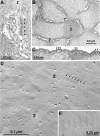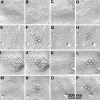Evolution of skeletal type e-c coupling: a novel means of controlling calcium delivery
- PMID: 16286507
- PMCID: PMC2171569
- DOI: 10.1083/jcb.200503077
Evolution of skeletal type e-c coupling: a novel means of controlling calcium delivery
Abstract
The functional separation between skeletal and cardiac muscles, which occurs at the threshold between vertebrates and invertebrates, involves the evolution of separate contractile and control proteins for the two types of striated muscles, as well as separate mechanisms of contractile activation. The functional link between electrical excitation of the surface membrane and activation of the contractile material (known as excitation-contraction [e-c] coupling) requires the interaction between a voltage sensor in the surface membrane, the dihydropyridine receptor (DHPR), and a calcium release channel in the sarcoplasmic reticulum, the ryanodine receptor (RyR). Skeletal and cardiac muscles have different isoforms of the two proteins and present two structurally and functionally distinct modes of interaction. We use structural clues to trace the evolution of the dichotomy from a single, generic type of e-c coupling to a diversified system involving a novel mechanism for skeletal muscle activation. Our results show that a significant structural transition marks the protochordate to the Craniate evolutionary step, with the appearance of skeletal muscle-specific RyR and DHPR isoforms.
Figures







Similar articles
-
Developmental and tissue-specific regulation of rabbit skeletal and cardiac muscle calcium channels involved in excitation-contraction coupling.Circ Res. 1994 Sep;75(3):503-10. doi: 10.1161/01.res.75.3.503. Circ Res. 1994. PMID: 8062423
-
Morphology and molecular composition of sarcoplasmic reticulum surface junctions in the absence of DHPR and RyR in mouse skeletal muscle.Biophys J. 2002 Jun;82(6):3144-9. doi: 10.1016/S0006-3495(02)75656-7. Biophys J. 2002. PMID: 12023238 Free PMC article.
-
Dihydropyridine receptor-ryanodine receptor interactions in skeletal muscle excitation-contraction coupling.Biosci Rep. 1995 Oct;15(5):399-408. doi: 10.1007/BF01788371. Biosci Rep. 1995. PMID: 8825041 Review.
-
Co-expression in CHO cells of two muscle proteins involved in excitation-contraction coupling.J Muscle Res Cell Motil. 1995 Oct;16(5):465-80. doi: 10.1007/BF00126431. J Muscle Res Cell Motil. 1995. PMID: 8567934
-
Ca2+ stores regulate ryanodine receptor Ca2+ release channels via luminal and cytosolic Ca2+ sites.Clin Exp Pharmacol Physiol. 2007 Sep;34(9):889-96. doi: 10.1111/j.1440-1681.2007.04708.x. Clin Exp Pharmacol Physiol. 2007. PMID: 17645636 Review.
Cited by
-
Selective coupling of type 6 adenylyl cyclase with type 2 IP3 receptors mediates direct sensitization of IP3 receptors by cAMP.J Cell Biol. 2008 Oct 20;183(2):297-311. doi: 10.1083/jcb.200803172. J Cell Biol. 2008. PMID: 18936250 Free PMC article.
-
Mint/X11 PDZ domains from non-bilaterian animals recognize and bind CaV2 calcium channel C-termini in vitro.Sci Rep. 2024 Sep 16;14(1):21615. doi: 10.1038/s41598-024-70652-8. Sci Rep. 2024. PMID: 39284887 Free PMC article.
-
A mechanism for graded motor control encoded in the channel properties of the muscle ACh receptor.Proc Natl Acad Sci U S A. 2011 Feb 8;108(6):2599-604. doi: 10.1073/pnas.1013547108. Epub 2011 Jan 24. Proc Natl Acad Sci U S A. 2011. PMID: 21262828 Free PMC article.
-
Response to Allard: A minor (albeit significant) role for voltage-induced calcium release in Caenorhabditis elegans muscles.Proc Natl Acad Sci U S A. 2024 Sep 24;121(39):e2415044121. doi: 10.1073/pnas.2415044121. Epub 2024 Sep 16. Proc Natl Acad Sci U S A. 2024. PMID: 39284058 Free PMC article. No abstract available.
-
Friends of Physiology: an interview with Clara Franzini-Armstrong and Clay Armstrong.J Gen Physiol. 2013 Nov;142(5):479. doi: 10.1085/jgp.201311115. J Gen Physiol. 2013. PMID: 24166877 Free PMC article. No abstract available.
References
-
- Chugun, A., K. Taniguchi, T. Murayama, T. Uchide, Y. Hara, K. Temma, Y. Ogawa, and T. Akera. 2003. Subcellular distribution of ryanodine receptors in the cardiac muscle of carp (Cyprinus carpio). Am. J. Physiol. 285:R601–R609. - PubMed
-
- Flood, P.R. 1977. The sarcoplasmic reticulum and associated plasma membrane of trunk muscle lamellae in Branchiostoma lanceolatum (pallas). A transmission and scanning electron microscopic study including freeze-fractures, direct replicas and x-ray microanalysis of calcium oxalate deposits. Cell Tissue Res. 181:169–196. - PubMed

